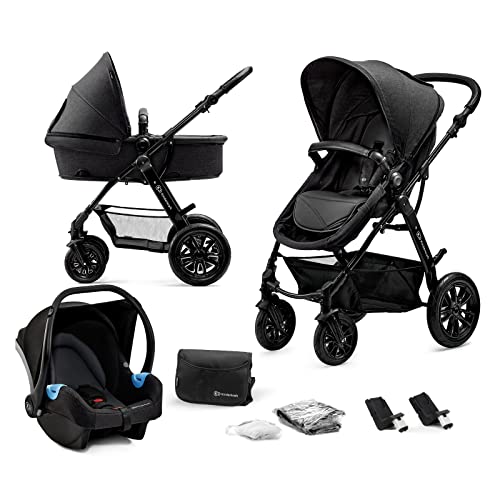Understanding Baby Prams and Pushchairs: A Comprehensive Guide
When it pertains to looking after a newborn or an infant, couple of products are as necessary as a trustworthy baby pram or pushchair. These movement aids supply a safe, comfy way to transport babies while permitting parents and caregivers the freedom to browse the world. This post checks out the different aspects of baby prams and pushchairs, assisting moms and dads make notified choices about which item might be best fit for their household's requirements.
What Are Baby Prams and Pushchairs?
Baby Prams: These are typically designed for infants and really young babies. They have totally reclining seats that permit a flat position, making them ideal for newborns. Prams frequently include a large, deep body, providing extra protection and convenience.
Pushchairs: Pushchairs, likewise called strollers, are more versatile and can normally be changed for young children also. They are lightweight, easy to maneuver, and typically feature a variety of seating positions, including reclined and upright.
| Function | Baby Prams | Pushchairs |
|---|---|---|
| Appropriate Age | Newborn to around 6 months | Newborn to 3 years or more |
| Seat Position | Fully reclined | Adjustable (reclined and upright) |
| Weight | Heavier, more robust | Lighter, more compact |
| Folding Mechanism | More complex folding | Normally simpler folding |
| Maneuverability | Can be less maneuverable | Highly maneuverable |
Key Features to Consider
When selecting a baby pram or pushchair, potential buyers need to think about a number of crucial features that can influence the use and convenience for both the kid and the caregiver.
1. Safety Features
- Five-point Harness: Ensures the baby is securely strapped in.
- Brakes: Reliable braking systems prevent mishaps.
- Stability: A broad base and well-constructed frame boost stability.
2. Convenience
- Padding: Ample cushioning on the seat ensures comfort.
- Suspension System: Provides a smoother ride on irregular surfaces.
- Canopy: A large, adjustable canopy safeguards the baby from sun and rain.
3. Portability
- Weight: Lighter models are easier to raise and bring.
- Folding Mechanism: Easy folding styles enable fast storage and transportation.
- Compact Size: A more compact size makes it easier to suit cars and truck boots and tight spaces.
4. Flexibility
- Convertible Options: Some designs can be changed from a pram to a pushchair.
- Reversible Seat: Allows the baby to face the moms and dad or the world, depending upon choice.
- Devices: Look for options that can accommodate cars and truck seats or have a storage basket.
5. Resilience
- Product Quality: Invest in higher-end products for durability.
- Weather condition Resistance: Water-resistant fabrics ensure that the pram/pushchair can withstand different weather.
Types of Baby Prams and Pushchairs
A number of types of baby prams and pushchairs fulfill various function requirements, aligning with moms and dads' particular way of lives.
1. Travel Systems
Travel systems typically combine a safety seat and a stroller in one package, permitting seamless transport from cars and truck to pram or pushchair without disrupting the baby.
2. Umbrella Strollers
Umbrella strollers are light-weight and convenient, created for easier maneuverability. sites are perfect for quick journeys and might lack some features discovered in full-size strollers.
3. All-Terrain Pushchairs
These are perfect for active families who take pleasure in hiking or taking walks on rugged terrains. They generally feature larger wheels for stability.
4. Jogging Strollers
Jogging strollers are created for parents who wish to integrate exercise with childcare. They include strong frames and fixed front wheels to improve safety throughout a run.
The Importance of Choosing the Right Option
Selecting the proper baby pram or pushchair is not simply a matter of preference; it straight impacts the safety and convenience of the baby. Furthermore, the best choice can profoundly influence the way of life of the caretakers.
Benefits:
- Convenience: A well-chosen pram or pushchair makes outings simpler and more pleasurable.
- Health: Proper assistance assists in spine and skeletal development in babies.
- Bonding: Outdoors play an important function in parent-child bonding.
Often Asked Questions (FAQs)
1. At what age can my baby utilize a pushchair?
The majority of pushchairs are designed to accommodate infants as young as six months, although some designs can be gotten used to safely transport newborns when used with suitable safety seat.
2. How do I keep my baby pram or pushchair?
Regular cleansing is necessary. Wipe down the frame and material with a moist cloth and moderate soap. Occasionally examine the wheels and brakes for wear and tear.
3. Can I utilize a baby pram for jogging?
Usually, no. Routine baby prams lack the stability and design needed for running. It is more secure to use a stroller particularly designed for that function.
4. How do I choose the right size?
Think about how typically you will be utilizing the pram/pushchair and where. If space is restricted, look for a more compact style. For outside adventures, choose one with larger wheels and excellent suspension.
Baby prams and pushchairs are invaluable tools for parents and caregivers, enabling safe and comfortable transportation of babies and young children. By comprehending the numerous features, types, and benefits included, caretakers can choose the very best movement aid fit to their requirements. Whether it be an advanced travel system or a simple umbrella stroller, the best purchase can significantly enhance the experience of parenthood, making getaways pleasurable and trouble-free for both parents and babies alike.

